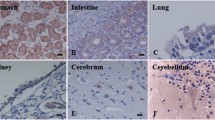Abstract
Major histocompatibility complex class II (MHC II) and canine distemper virus (CDV) antigen expression were compared by immunohistochemistry in the cerebellar white matter of ten dogs with naturally occurring canine distemper encephalitis. In addition, infiltrating mononuclear cells were characterized by employing poly- and monoclonal antibodies directed against human CD3, canine MHC II, CD5, B cell antigen and CDV-specific nucleoprotein. Positive antigen-antibody reaction was visualized by the avidin-biotin-peroxidase complex method on frozen sections. Histologically, neuropathological changes were categorized into acute, subacute, and chronic. In control brains, MHC II expression was weak and predominantly detected on resident microglia of the white matter and on endothelial, perivascular and intravascular cells. In CDV antigen-positive brains, MHC II was mainly found on microglia and to a lesser extent on endothelial, meningeal, choroid plexus epithelial, ependymal and intravascular cells. In addition, virtually all of the perivascular cells expressed MHC II antigen. CDV antigen was demonstrated most frequently in astrocytes. Of the perivascular lymphocytes, the majority were CD3-positive cells, followed by B cells. Only a small proportion of perivascular cells expressed the CD5 antigen. In addition, B cells and CD3 and CD5 antigen-positive cells were found occasionally in subacute and frequently in chronic demyelinating plaques. In acute encephalitis, CDV antigen exhibited a multifocal or diffuse distribution, and MHC II was moderately up-regulated throughout the white matter and accentuated in CDV antigen-positive plaques. In subacute encephalitis, moderate multifocal CDV antigen and moderate to strong diffuse MHC II-specific staining, especially prominent in CDV antigen-positive lesions, were observed. In chronic encephalitis, CDV antigen expression was restricted to single astrocytes at the edge of the lesions or was absent, while MHC II expression, especially prominent on microglia, was strongly up-regulated throughout the white matter, most pronounced in demyelinated plaques. In summary, in acute and subacute lesions without perivascular cuffs, MHC II expression correlated with the presence of CDV antigen. In contrast, in chronic lesions, MHC II expression on microglial cells was the most prominent despite a few CDV antigen-positive astrocytes, indicating that nonviral antigens may play an important role as triggering molecules for the process of demyelination.
Similar content being viewed by others
Author information
Authors and Affiliations
Additional information
Received: 13 September 1995 / Revised: 26 February 1996 / Accepted: 1 April 1996
Rights and permissions
About this article
Cite this article
Alldinger, S., Wünschmann, A., Baumgärtner, W. et al. Up-regulation of major histocompatibility complex class II antigen expression in the central nervous system of dogs with spontaneous canine distemper virus encephalitis. Acta Neuropathol 92, 273–280 (1996). https://doi.org/10.1007/s004010050518
Issue Date:
DOI: https://doi.org/10.1007/s004010050518




